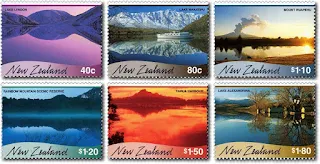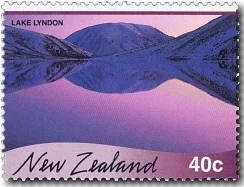In the North Island, we visited Mount Ruapehu ($1.10), the spectacular 1995 eruption of which is captured in a reflection in the lake below. In nearby Rotorua, the Rainbow Mountain Scenic Reserve ($1.20) overlooks a geothermal pond, a natural phenomenon to be found throughout the area. On the east of the Coromandel Peninsula, we find Tairua Harbour ($1.50). The harbour is the base for numerous game-fishing boat charters catching marlin, tuna, snapper, kingfish and crayfish.
The South Island selection includes Lake Wakatipu ($0.80), New Zealand's third largest lake - and its longest at 84 kilometres (it is less than five kilometres wide). A popular location for bungy jumping and jet boat rides, Lake Wakatipu's waters also host leisurely cruises, such as those provided by the elegant Lion, which featured on this stamp. Built in 1908, the Lion was extensively restored in the 1990s, complete with a new colour scheme, polished brass fittings, teak and kauri woodwork and English wool carpet.
The Stamps.
40c - Lake Lyndon.
Located near Arthur’s Pass, inland Canterbury, Lake Lyndon is a glacial lake shadowed by the towering and snow-covered Craigieburn, Torlesse and Big Ben ranges. The mountain of the same name, Mount Lyndon (1,475 metres) overlooks the small lake, with the larger Lake Coleridge further to the west.
Lake Lyndon is a popular spot for people taking a break on the trip between the east and west coasts of the South Island. The rugged road, State Highway 73, has an interesting history of supporting the trade in gold and greenstone in the 19th and early 20th centuries.
High country tussock grasslands, shrublands and mountain beech forest surround the lake, which is home to the threatened banded dotterel and crested gebe. One of the area's well-recognised inhabitants is the cheeky kea. These alpine parrots with their dark khaki body and bright orange under their wings are comical and inquisitive.
80c - Lake Wakatipu.
Lake Wakatipu, with an area of 291 square kilometres, is New Zealand’s third largest lake – and its longest at 84 kilometres and less than five kilometres wide. The lake is subject to natural phenomena termed seiches were its level appears to pulsate, rising and falling by up to as much as 12 centimetres every five minutes or so. According to Maori legend, this is caused by a giant taniwha breathing as he sleeps at the bottom of the lake.
A popular location for bungy jumping and jet boat rides, Lake Wakatipu’s waters also hosted leisurely cruises, such as those provided by the elegant Lion, which featured on this stamp. Built in 1908, Lion was extensively restored in the 1990s, complete with a new colour scheme, polished brass fittings, teak and kauri woodwork and English wool carpet.
Set on the shores of the lake is one of New Zealand's most popular tourist resorts, Queenstown. Queenstown was first settled in the 1860s during the gold-mining era. Today, the area's gold-mining history is one of a huge variety of tourist attractions, from adrenalin-pumping bungy jumps to more leisurely trips cruising Lake Wakatipu. In winter Queenstown is incredibly busy, with five ski fields nearby, people head to the action town for skiing holidays.
$1.10 - Mount Ruapehu.
The highest mountain in New Zealand’s North Island at 2,797 metres, Ruapehu received international attention in 1995 and 1996 for its dramatic volcanic explosions. Huge clouds of ash and steam were expelled skyward, coating the surrounding snow fields and forest with a thick layer of dark grey ash. The stamp captured Ruapehu's spectacular 1995 eruption reflected in the lake below. The crater lake, covering the vent of Ruapehu, was drained of water by the explosions.
In 1953, the crater lake was the cause of a much more tragic event. A blockage at the outlet of the crater lake collapsed, causing a massive lahar, or flood of water, mud and ash and other volcanic debris, that swept down the slopes of Ruapehu, destroying the rail bridge at Tangiwai. A train plunged into the river and 151 people died.
Ruapehu is the southernmost peak of the three mountains in the central plateau, south of Lake Taupō. Tongariro and Ngauruhoe, along with Ruapehu, are the heart of the Tongariro National Park.
$1.20 - Rainbow Mountain Scenic Reserve.
Rainbow Mountain is a colourful part of Bay of Plenty’s volcanic landscape of boiling mud and steaming pools. Maungakākaramea, as it is also known, means mountain of coloured earth. The mountain has bare brown, orange and red steaming slopes, as the backdrop to two tiny crater lakes. The crater lakes are among five small lakes dotting the reserve. The area surrounding the lakes is covered in thriving native plants including cabbage trees, flax bushes and mānuka.
The summit track to the top of Rainbow Mountain provides dramatic views of the triple peaks of Tongariro National Park to the south and Mount Tarawera and Lakes Tarawera and Rotomahana to the north. Lake Rotomahana was once the home of the Pink and White Terraces that were made famous worldwide through a series of delicate coloured lithographs. However, when Mount Tarawera erupted in 1886 the terraces were completely destroyed.
$1.50 - Tairua Harbour.
On the east of the Coromandel Peninsula, famous for its beaches, bush and gold mining history, is Tairua Harbour. Opposite the resort township of Pāuanui, Tairua has historically been an area of farming and sawmilling, although tourism, especially eco-tourism, has grown in strength.
The Corondel is a haven for those looking for great beaches, fishing and scuba diving. The port at Tairua is a handy base for game fishing charters out to the Aldermen and other islands, with marlin and tuna caught from time to time, along with snapper, kingfish and crayfish. As a variation to sea fishing, there are trout in the upper reaches of the Tairua River.
Te Whanganui-a-Hei (Cathedral Cove) Marine Reserve provides another option for those who enjoy marine life other than fishing. Snorkelling or scuba diving around the reefs and islands within the marine reserve gives a different view of the underwater life around the Coromandel.
$1.80 - Lake Alexandrina.
The Mackenzie Country’s Lake Alexandrina is small and delicate when compared to the mighty Lake Tekapo to its east, one of the South Island’s largest lakes. Its clear water contrasts with the opaque turquoise waters of the glacier-fed Tekapo and neighbouring Lake Pukaki.
Motorised boats are not allowed on Lake Alexandrina, making it an attractive option for those seeking peaceful picnicking or undisturbed fishing. Alexandrina is a favoured spot with trout anglers and a few quaint baches, or cribs as known in the South Island, dot the shoreline.
The dry flat grasslands surrounding the lake are home to native skinks and geckos. The lake holds one of the largest single populations of the threatened southern crested grebe and also the scaup, a small black duck with yellow eyes. One of New Zealand's most threatened native birds, the black stilt lives in the braided rivers of the Mackenzie Country nearby.
First Day Cover - 7 July 2000.
Canpex 2000.
The Hotel Chancellor in central Christchurch hosted the national stamp exhibition from 5 to 8 October 2000. The 'Canpex 2000' exhibition commemorated the 150th Anniversary of Canterbury. To commemorate this event, New Zealand Post released a miniature sheet including two of the July 2000 dramatic Scenic Reflections stamps with a backdrop of the Christchurch Pier at New Brighton, and a souvenir envelope featuring the exhibition logo and a date stamp for the 2000 Children's Health - Bears & Dolls stamp issue released on the exhibitions opening day. The Scenic Reflections stamps were selected because both Lake Lyndon and Lake Alexandrina are in the Canterbury region.
Canpex 2000 Miniature Sheet.
The stamps are the 40c Lake Lyndon and the $1.80 Lake Alexandrina. The background image was chosen for its significance to Canterbury. The construction for the Christchurch Pier began in February 1996 and was completed in November 1997. Anchoring this 300m long pier, the library building notably won the 2000 New Zealand top award for architecture.
Miniature Sheet First Day Cover - 5 October 2000.
The First Day Cover shows the beautiful River Avon the winds its way through the centre of Christchurch City.
Technical Information - 2000 Scenic Reflections.
Date of issue: 7 July 2000.
The number of stamps: Six.
Denominations and designs: 40c Lake Lyndon, 80c Lake Wakatipu, $1.10 Mount Ruapehu, $1.20 Rainbow Mountain Scenic Reserve, $1.50 Tairua Harbour, and $1.80 Lake Alexandrina.
Stamps and first-day cover designed: Donna McKenna, Wellington, New Zealand.
Printer and process: Southern Colour Print, Dunedin, New Zealand, by offset lithography.
The number of colours: Four process colours.
Stamp size and format: 40mm x 30mm horizontal.
Paper type: 103gsm De la Rue red phosphor coated stamp paper.
The number of stamps per sheet: 100.
Perforation gauge: 14.
Period of sale: These stamps remained on sale until 6 July 2001.
Technical Information - Canplex 2000.
Date of issue: 5 October 2000.
Miniature sheet and souvenir envelope designed: New Zealand Post Stamps Business.
Printer and process: Southern Colour Print, Dunedin, by offset lithography.
The number of colours: Four process colours.
Paper type: 103 gsm red phosphor coated.
Period of sale: These stamps remained on sale until 4 October 2001.
Some of the images in this post were used with permission from the illustrated catalogue of StampsNZ
You can visit their website and Online Catalogue at, http://stampsnz.com/
Information & images for this post came from.










We appreciate your engagement with our content. To ensure a respectful and constructive community, please take note of the following:
- No Spam, Please: We do not tolerate spammy or promotional comments. Any such comments will be promptly removed.
- Moderation in Place: All comments are moderated to maintain a positive and inclusive environment. Please be patient, as it may take a little time for your comment to appear.
- Sign In with Google: To comment, please sign in using your Google account. This helps us maintain the integrity of our community and allows for better interaction.